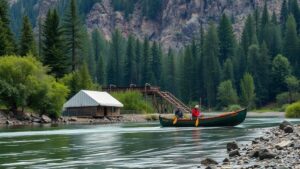How to Identify Wind-Blown Markers That Point to Lost Treasures
Introduction
Geological phenomena and environmental factors create distinctive markers in various landscapes that may signal the presence of lost treasures. Among these, wind-blown markers serve as important indicators, guiding treasure hunters and researchers alike toward potentially valuable discoveries. This article explores how to identify such markers effectively, combining an understanding of environmental science, historical context, and practical methodologies.
Understanding Wind-Blown Markers
Wind-blown markers are formations created by the movement of sand, dust, and sediment due to prevailing winds. e features can vary significantly in size and shape and include sand dunes, ripples, and other erosional artifacts. Recognizing these formations entails an understanding of how wind interacts with different geographies. For example, in arid regions, sand dunes can shift dramatically, while coastal areas may display beach erosion or deposition patterns.
Types of Wind-Blown Markers
- Sand Dunes: Large hills of sand formed by wind action, which can indicate nearby water sources or human activities.
- Ripples: Smaller, wave-like formations that can reveal the direction of wind flow and may lead to buried artifacts.
- Dust Accumulations: Piles of silt and clay that can trap organic material, providing clues to past human habitation.
Environmental Factors Influencing Marker Formation
The identification of wind-blown markers requires a keen awareness of environmental conditions. Several factors influence how these markers form and their potential significance in locating lost treasures.
Wind Patterns
Understanding prevailing wind patterns is crucial for treasure hunting. For example, in the western United States, the southwest winds typically dominate, influencing the formation of dunes aligned from northwest to southeast. Analyzing historical data on wind patterns can guide researchers on where to focus their searches for artifacts or buried treasures.
Soil Composition
The type of soil present in an area affects how easily it can be shaped by wind. Sandy soils, for instance, are more susceptible to creating distinct dune shapes compared to clay-based soils that may more likely lead to erosion. Studies have shown that areas with a higher composition of sandy soil correspond with increased incidences of buried artifacts, making them prime locations for exploration.
Identifying Clues in the Landscape
To effectively identify wind-blown markers, treasure hunters must develop skills in landscape analysis, recognizing not only the markers themselves but also associated clues in a given area.
Visual Cues
Key visual indicators like the direction of dune slopes, abnormal erosion patterns, and vegetation line can signal the presence of undiscovered treasures. For example, if a vegetation line appears to be interrupted, this may indicate that an ancient building hidden beneath has shifted soil over time.
Use of Technology
Modern technology, such as Geographic Information Systems (GIS) and satellite imagery, allows for more precise mapping of wind patterns and landscape shifts, assisting in identifying areas worth investigating. For example, researchers have used GIS technology to reveal hidden archaeological sites in the deserts of Egypt, where wind patterns had obscured potential treasures beneath shifting sands.
Case Studies: Identifying Lost Treasures
Learning from past explorations can yield valuable insights into identifying wind-blown markers. Here are two significant case studies:
The Lost Treasure of the Flor de la Mar
In 1511, the Flor de la Mar, a Portuguese ship, sank off the coast of Malaysia while carrying a vast treasure. Over the years, researchers identified changes in coastal wind patterns that had influenced the sediment distribution, helping to narrow down search areas. Although the treasure remains lost, targeted searches based on wind patterns have yielded some artifacts from the era.
The Sands of Time: Ancient City Discovered
In 2013, researchers used drones and satellite mapping in the Arabian Peninsula to uncover remnants of an ancient city. Wind-blown markers like disturbed sand layers and vegetation clues revealed structures buried beneath dunes. This technological approach has been critical in treasure identification, offering a model for future searches.
Conclusion
Identifying wind-blown markers that point to lost treasures involves a multi-faceted approach, blending environmental science with historical research and modern technology. By understanding the types of wind-blown formations, environmental factors impacting their presence, and carefully analyzing the landscape, treasure hunters can increase their chances of successful discoveries. The key takeaway for aspiring hunters is to combine traditional exploration methods with advanced technologies to unlock the secrets buried within our landscapes.
Actionable Takeaways
- Study local wind patterns to understand potential marker formation.
- Use technology such as GIS for mapping and analysis of potential treasure locations.
- Look for visual cues in landscapes that may indicate human activity or historical deposits.



